Pepper jelly is an old-fashioned treat that you can easily make in your kitchen today! This pepper jelly recipe is sweet and sour, with an option for adding a kick of spice. This is a great way to use up end-of-season garden peppers.
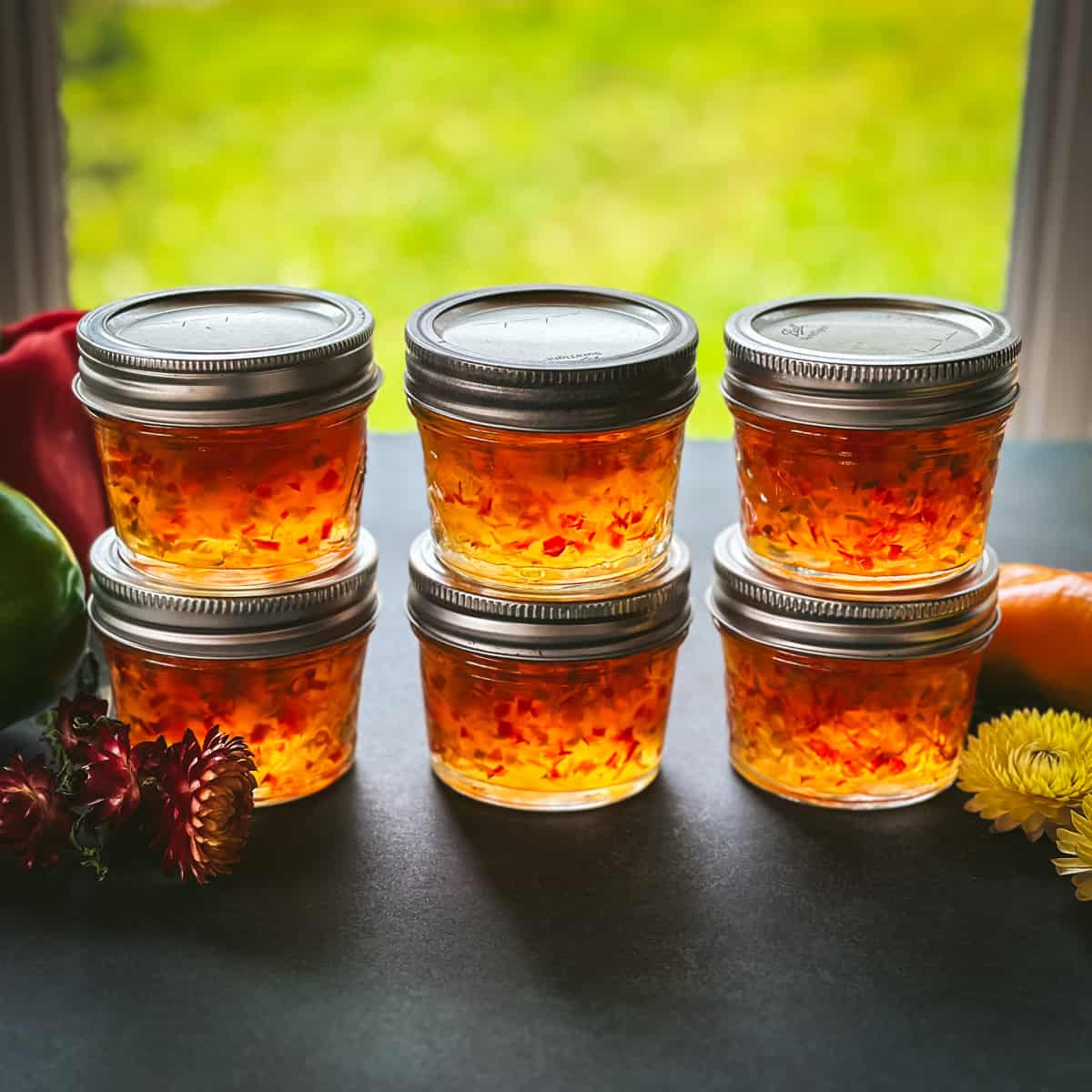
Want to save this post for later?
Pepper jelly has been popular since my Grandmother’s day, and for good reason. This spread is deliciously sweet and sour, and sometimes spicy, depending on the peppers you use.
An old-school famous topping for cream cheese as an appetizer with crackers, this pepper jelly recipe won’t disappoint! Easy, sweet, sour, and perhaps a bit of spice, it’s a great way to use up the last of your garden peppers.
If you have a ton of jalapeño peppers to use, I recommend using the leftovers from this recipe for pickled jalapeños, which is another delicious way to preserve hot peppers.
I use Pomona’s Pectin in this recipe, so this is a lower-sugar recipe than many jelly recipes. Pomona’s comes with 2 packets, one to make calcium water and one for pectin. It is easy to use and worth it for less sugar.
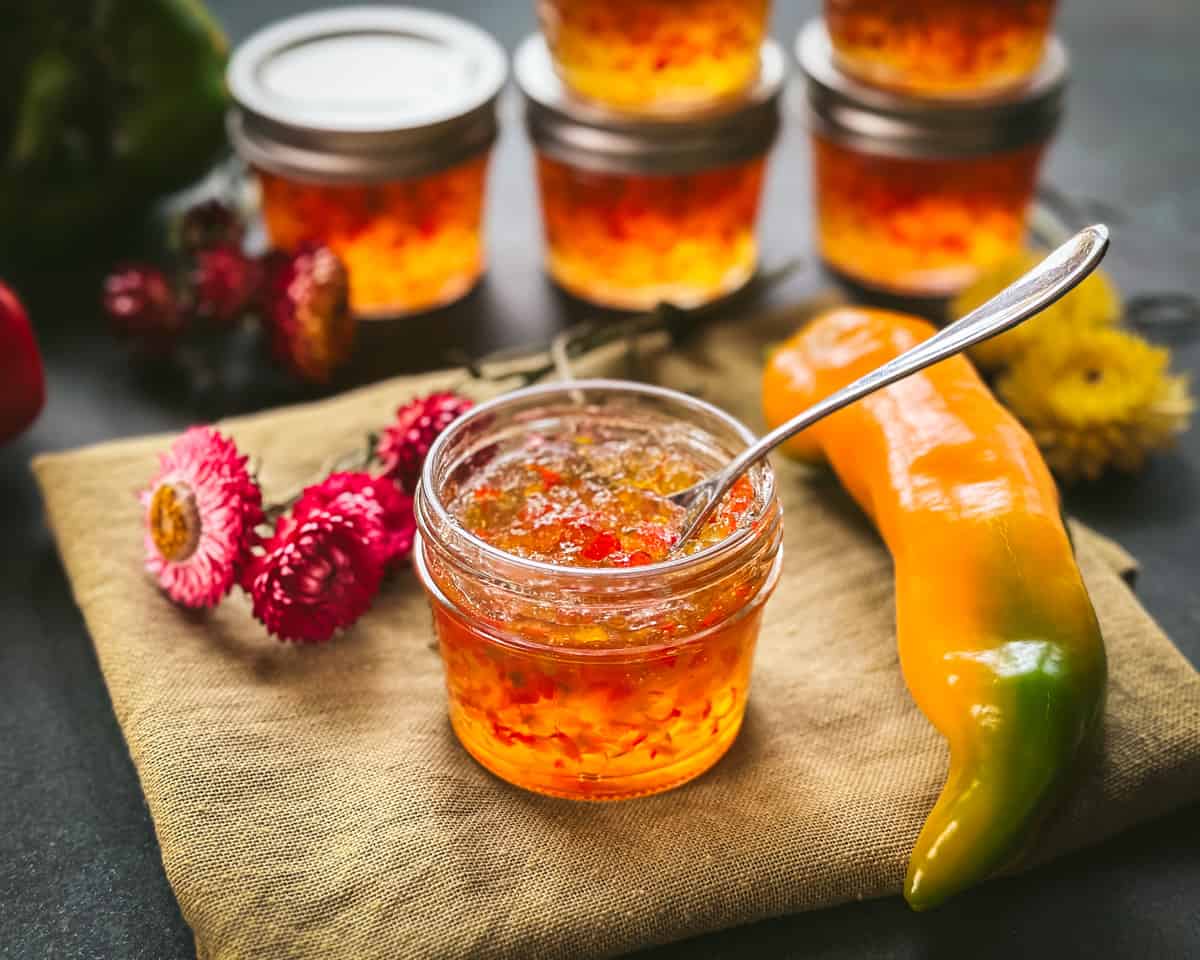
Pepper Jelly Recipe
This recipe is made with my garden-grown red, yellow, and green bell peppers, but any type of peppers will work. Use what you have on hand, and don’t be afraid to use hot peppers! They go delightfully well in this recipe for a balance of sweet and spicy.
Get more recipes for canning, fermenting, quick pickling, dehydrating, and freezing so that you can enjoy your summer produce year-round in my ebook Preserving the Garden Harvest!
Ingredients
Peppers: Both bell and hot peppers work wonderfully for pepper jelly. Use any variety of bell peppers for sweet and sour jelly, or a mix of any hot and bell peppers for sweet and spicy jelly. Another option is to use all spicy peppers for very hot pepper jelly! Mix it up however you want it.
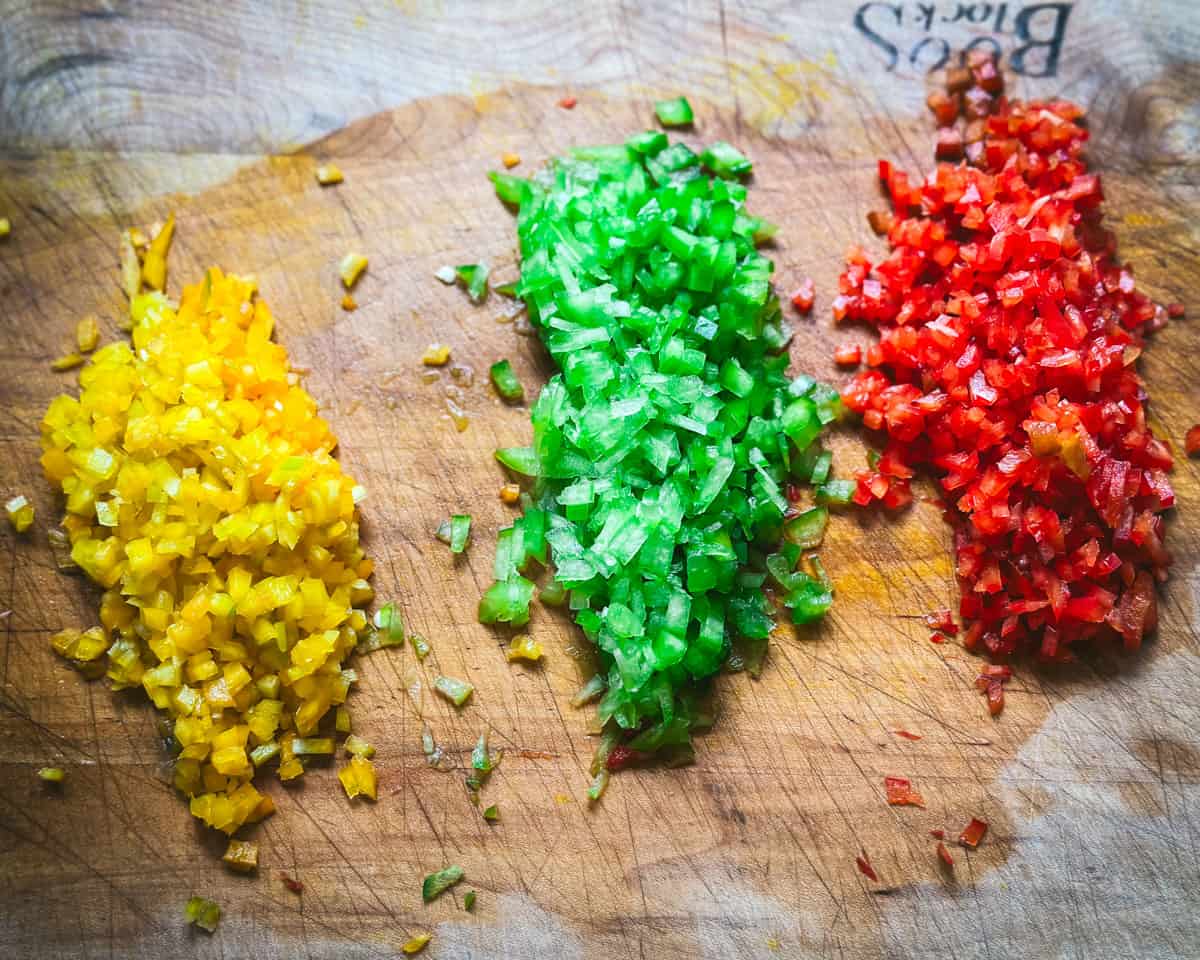
White vinegar: Make sure to use white vinegar that has 5% acidity. Apple cider vinegar can be substituted as long as it has 5% acidity. Vinegar makes for a lovely sour taste with bell peppers in this recipe!
Calcium water: One of the packets in Pomona’s Pectin box will be for calcium water. Mix it up following the directions on the box and save the rest in the fridge if there are leftovers.
Sugar: I like to use organic sugar, or substitute it with honey.
Pomona’s Pectin: This box of Pomona’s Pectin will have 2 packets. One is the pectin, and one is for mixing the calcium water.
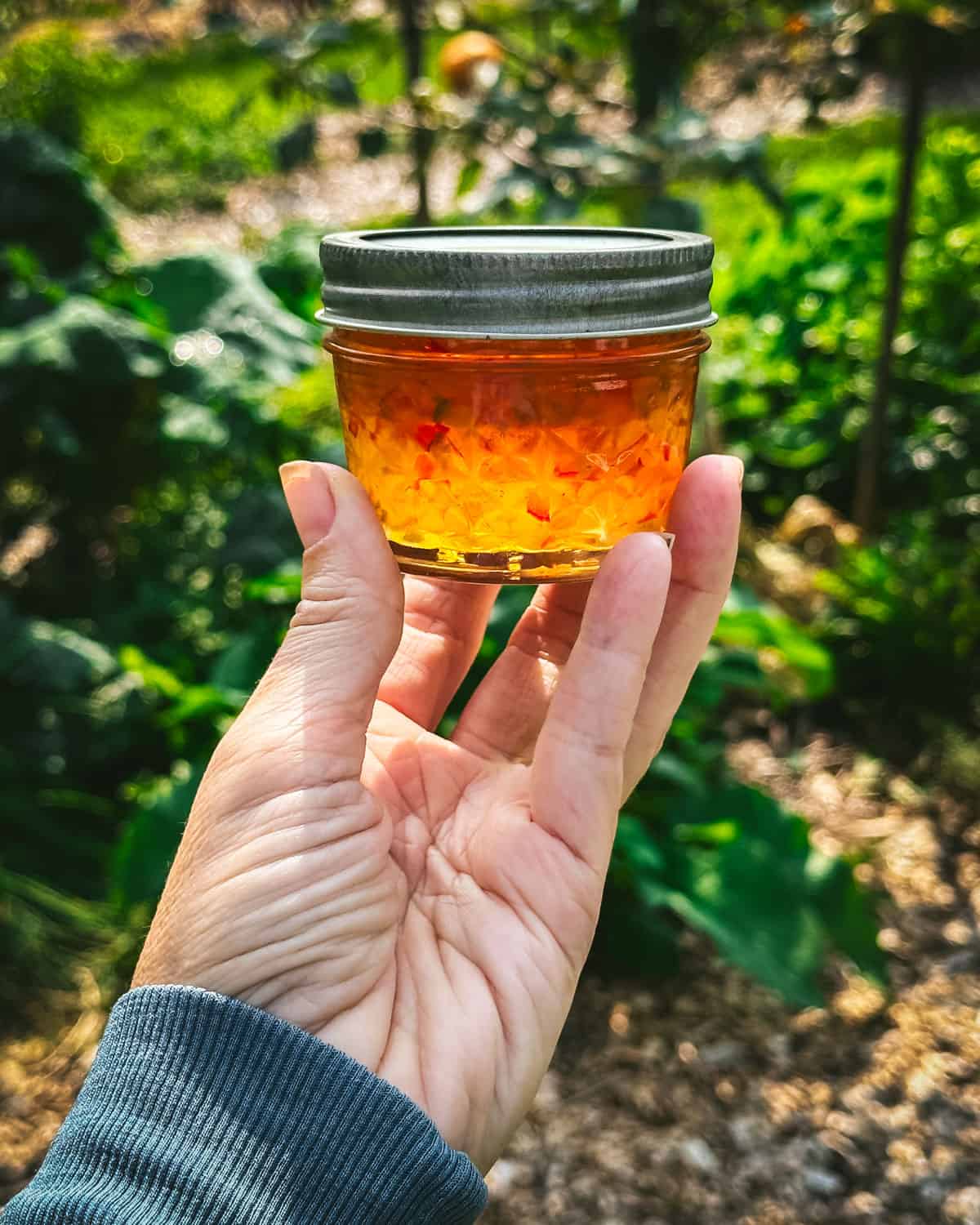
How to Make Pepper Jelly
First, prepare your boiling water bath canner so it is ready for the water bath method.
- Place the canning rack at the bottom of a large pot and heat the jars in simmering water until it’s time to use them.
- Wash the jar lids in warm soapy water and then set them aside so they’re ready for later.
- Mix up the calcium water as per Pomona’s Pectin instructions.
Cook the Pepper Jelly
Now, measure the finely chopped peppers of your choice into a saucepan. I used a mix of mild red, green, and yellow bell peppers, which turned out really pretty and with a yummy sweet and sour taste.
Next, add the vinegar to the saucepan. Bring the peppers and vinegar to a boil and cover the pot. Simmer this mixture for 5 minutes.
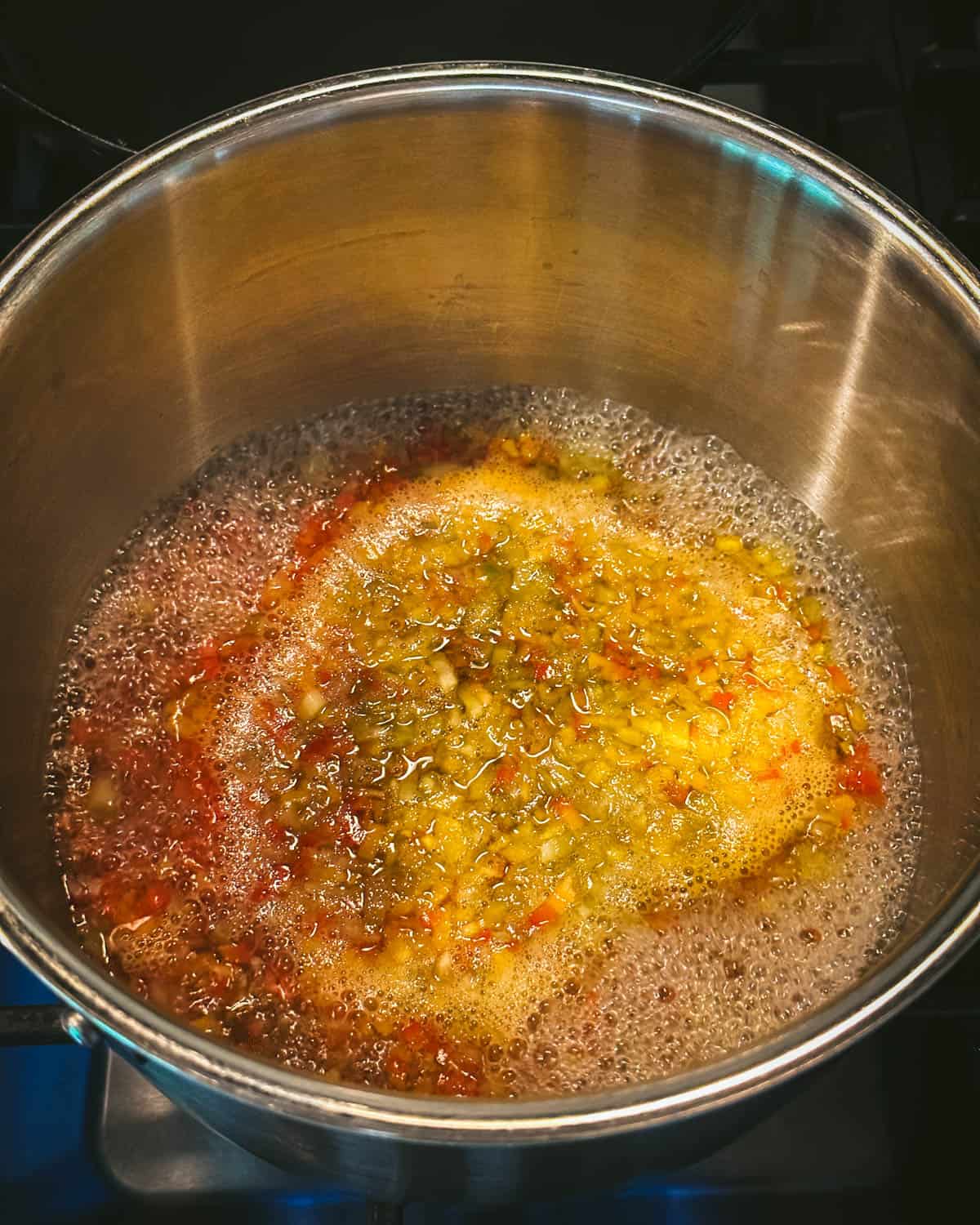
Turn the stove heat off, and add 2 teaspoons of the calcium water. Mix it in well.
Measure ½ cup of the sugar, or ½ cup of honey, into a bowl. Thoroughly mix the pectin powder into the ½ cup of sweetener. Then set it aside.
Now, return the pepper mixture to the heat and bring it to a full boil. Add the pectin-sweetener mixture with the boiling peppers, and stir vigorously for 1 to 2 minutes to dissolve the pectin.
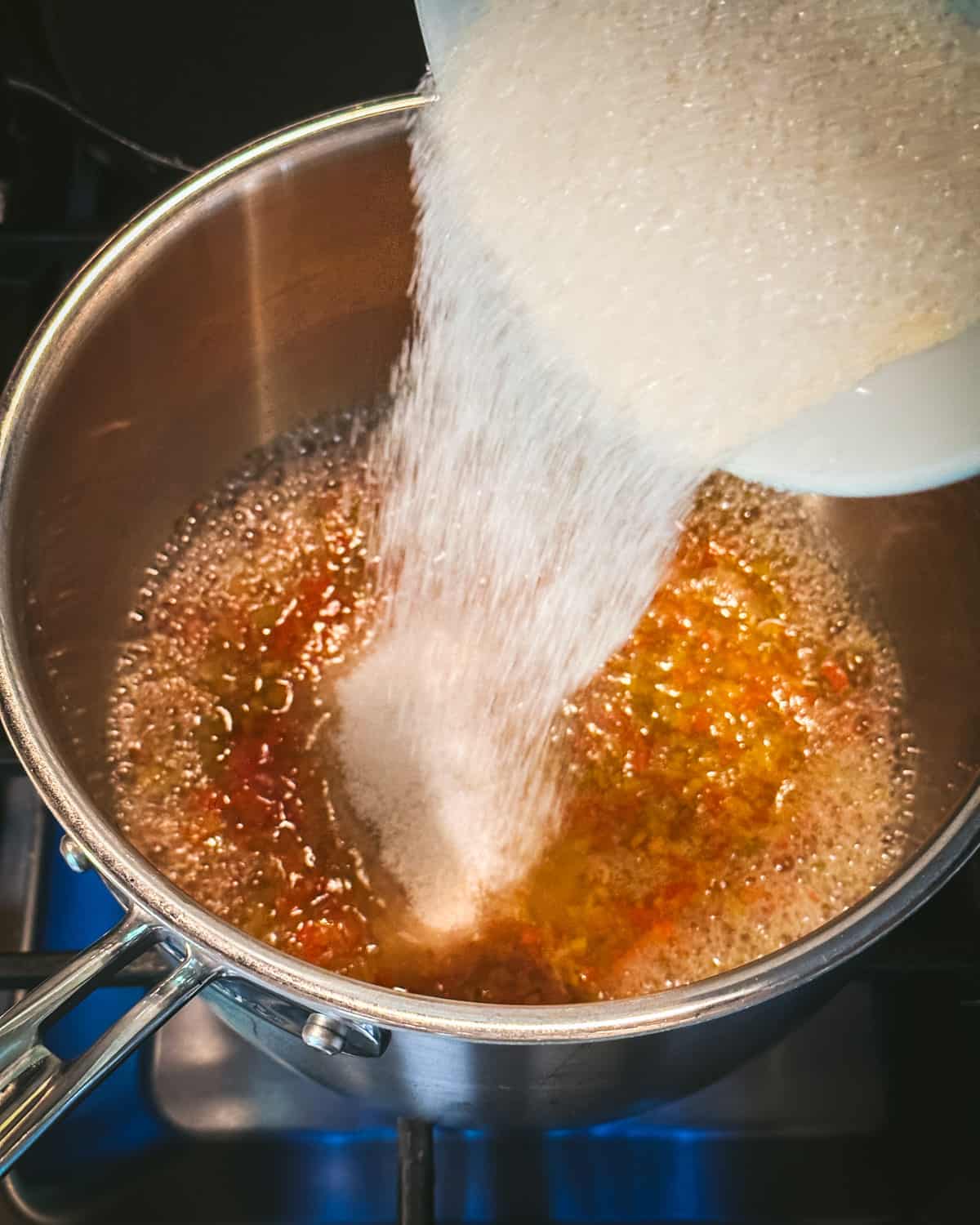
Once the pectin is dissolved, add the rest of the sugar or honey to the pepper mixture. Stir it well and return the jelly mixture to a full boil, then remove it from the heat.
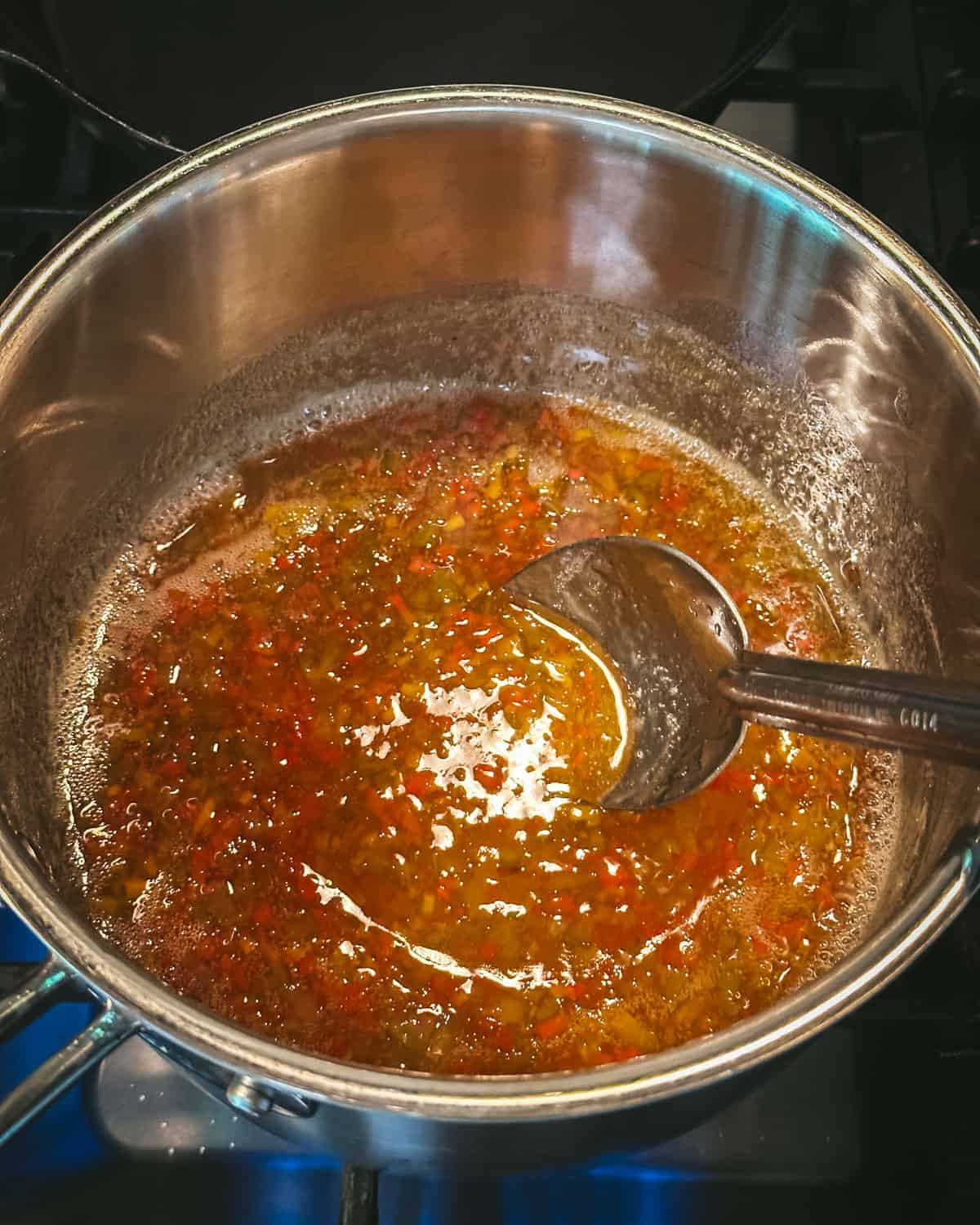
Use a jar lifter to place the warmed jars onto a wooden cutting board or kitchen towel.
Then ladle the hot jelly into a canning funnel to pour the pepper jelly into the prepared jars.
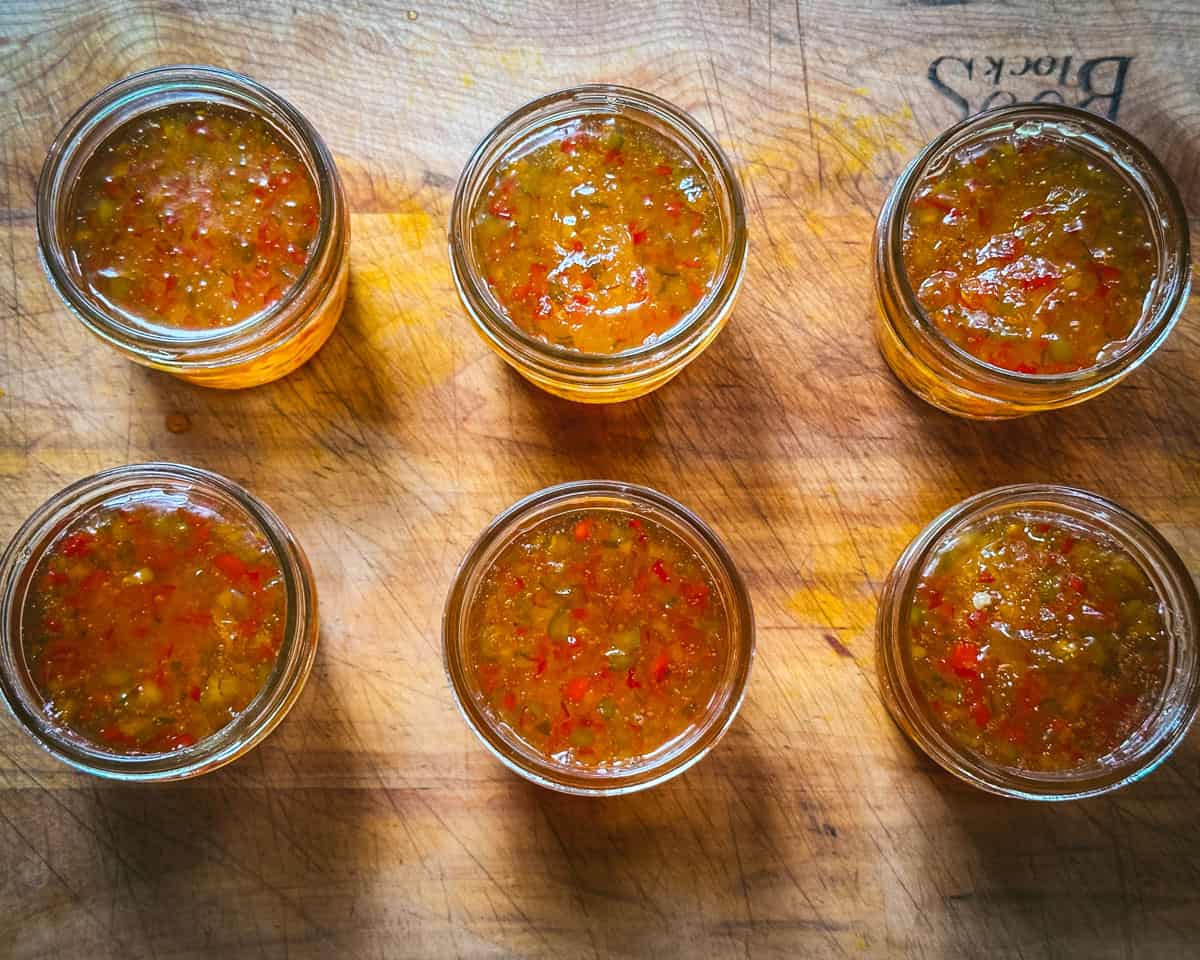
Make sure to leave around 1/4 inch of headspace and remove any air bubbles.
Wipe the rims of the jelly jars. Center a lid onto each jar and apply the band, closing each lid just to fingertip tight.
Process for Canning
Place the filled jars into the prepared boiling water canner. Make sure there is 1-2 inches of water covering the jelly jars.
Process the jars in a boiling water bath for 10 minutes (add 1 minute more for every 1,000 ft. above sea level). Then, turn off the heat and remove the pot lid. Let the jars sit inside the bath for 5 more minutes.
Use a jar lifter to remove the hot jars of pepper jelly and let them cool for about 12 to 24 hours.
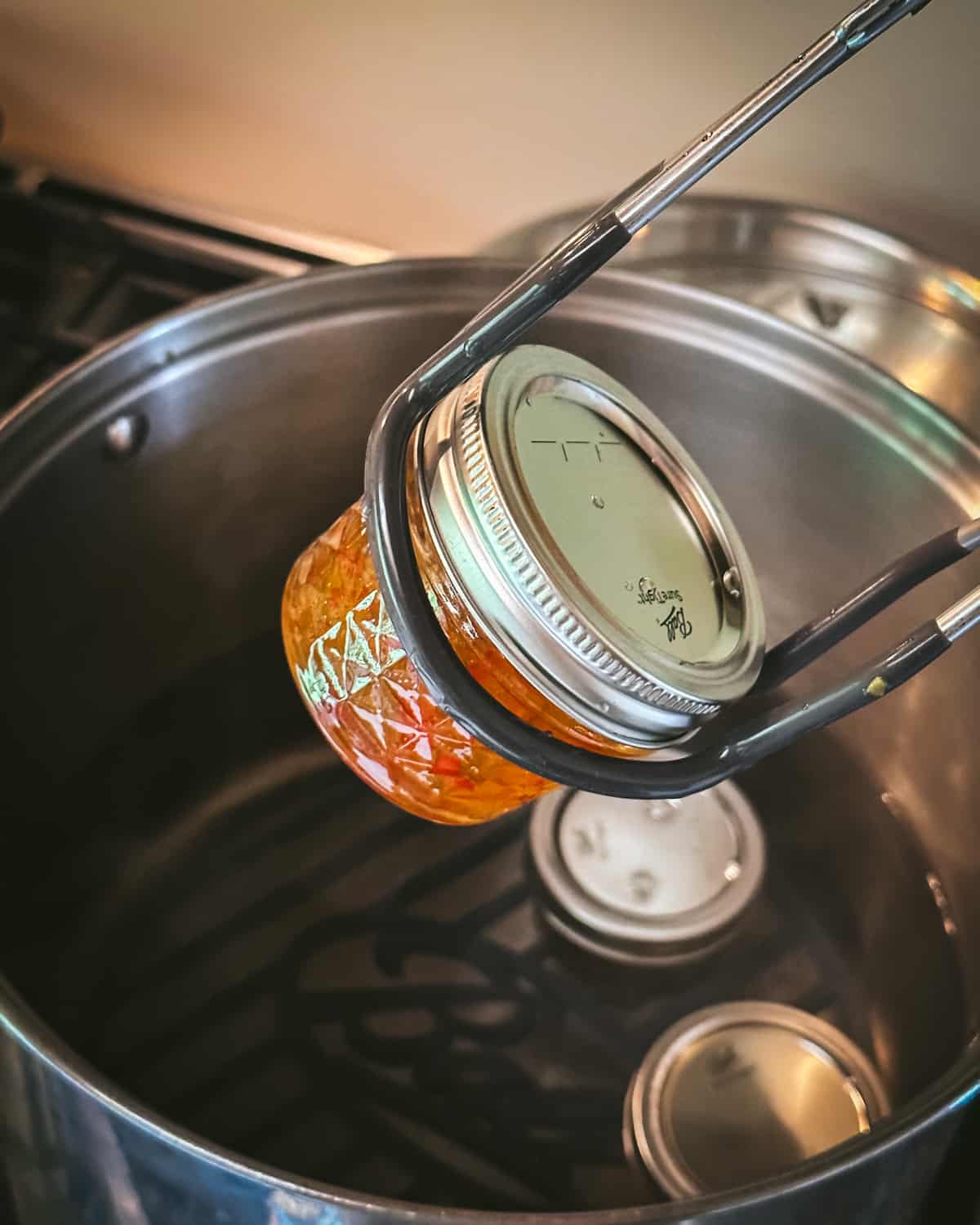
Lastly, check to make sure the lids are all sealed properly. They should not flex when the center is pressed.
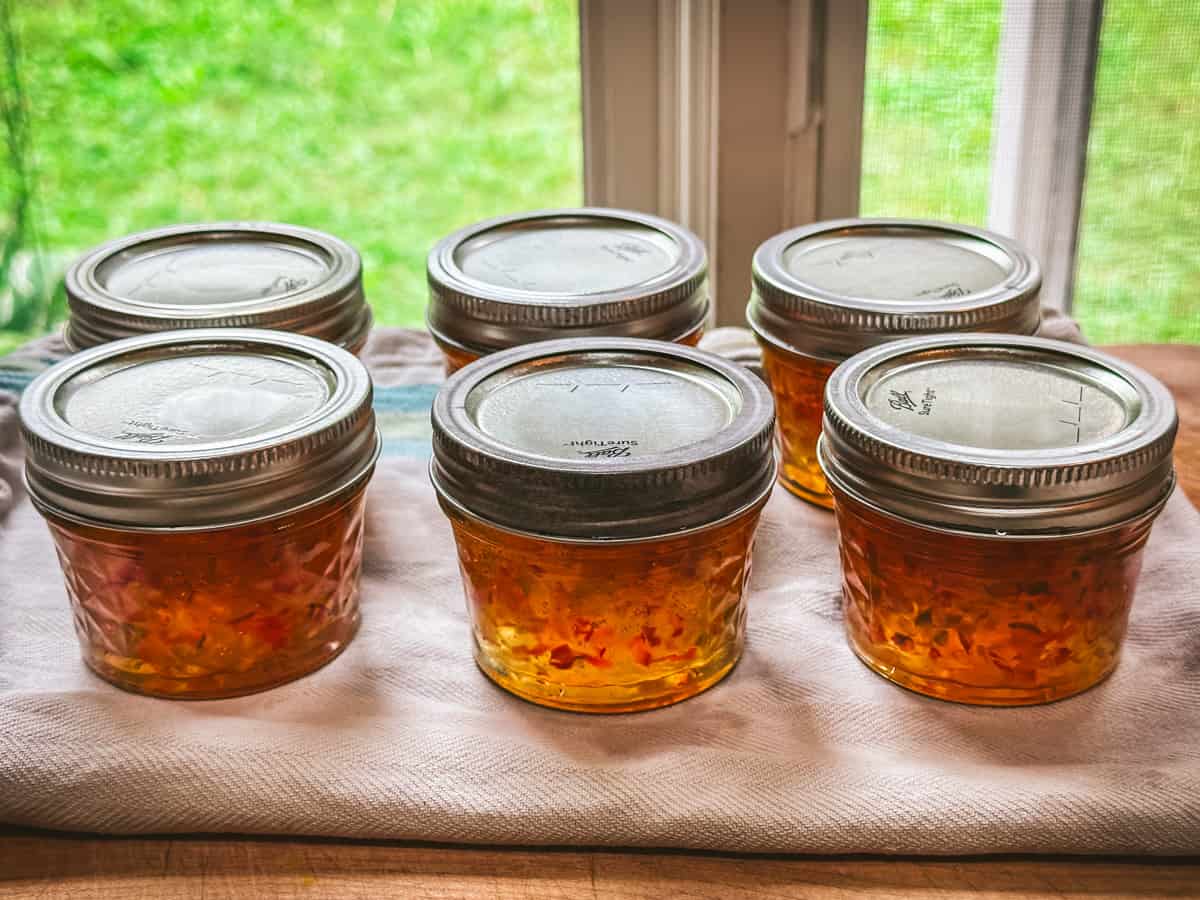
Now enjoy this tasty sweet and sour, sweet and spicy, or hot pepper jelly!
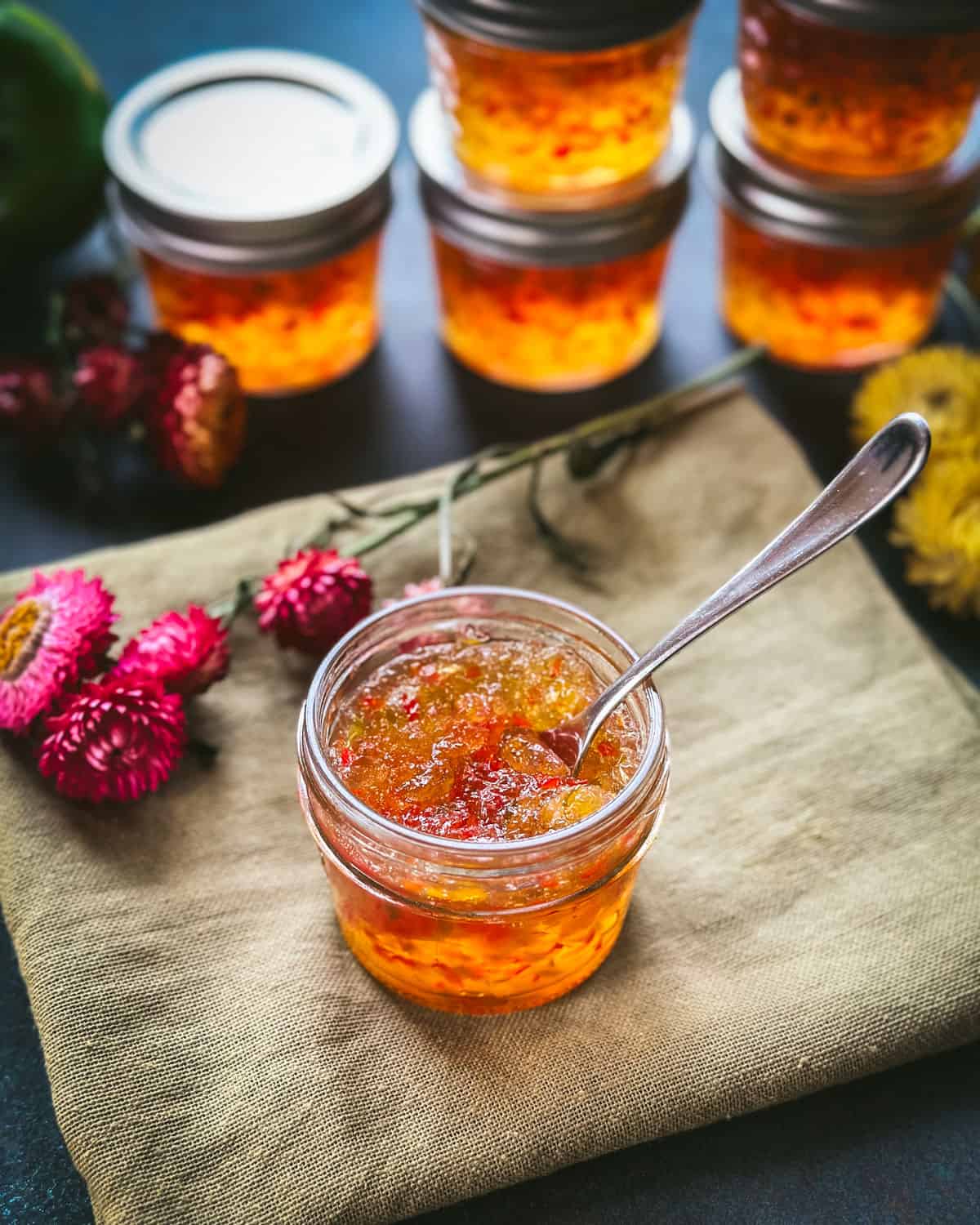
How to Eat and Store Pepper Jelly
For a super tasty appetizer that will blow the socks off of all of your guests, make this simple pepper jelly cream cheese appetizer. It’s so good and is perfect for happy hour or for a holiday snack.
Speaking of holidays, homemade pepper jelly makes a great gift. It has an old-fashioned and unique taste that everyone will appreciate, whether you make sweet and sour or hot pepper jelly.
Better yet, make both! True to its old-fashioned popularity, you can really use pepper jelly in almost anything. You’ll be dipping everything in it before you know it, and not a bit will go to waste.
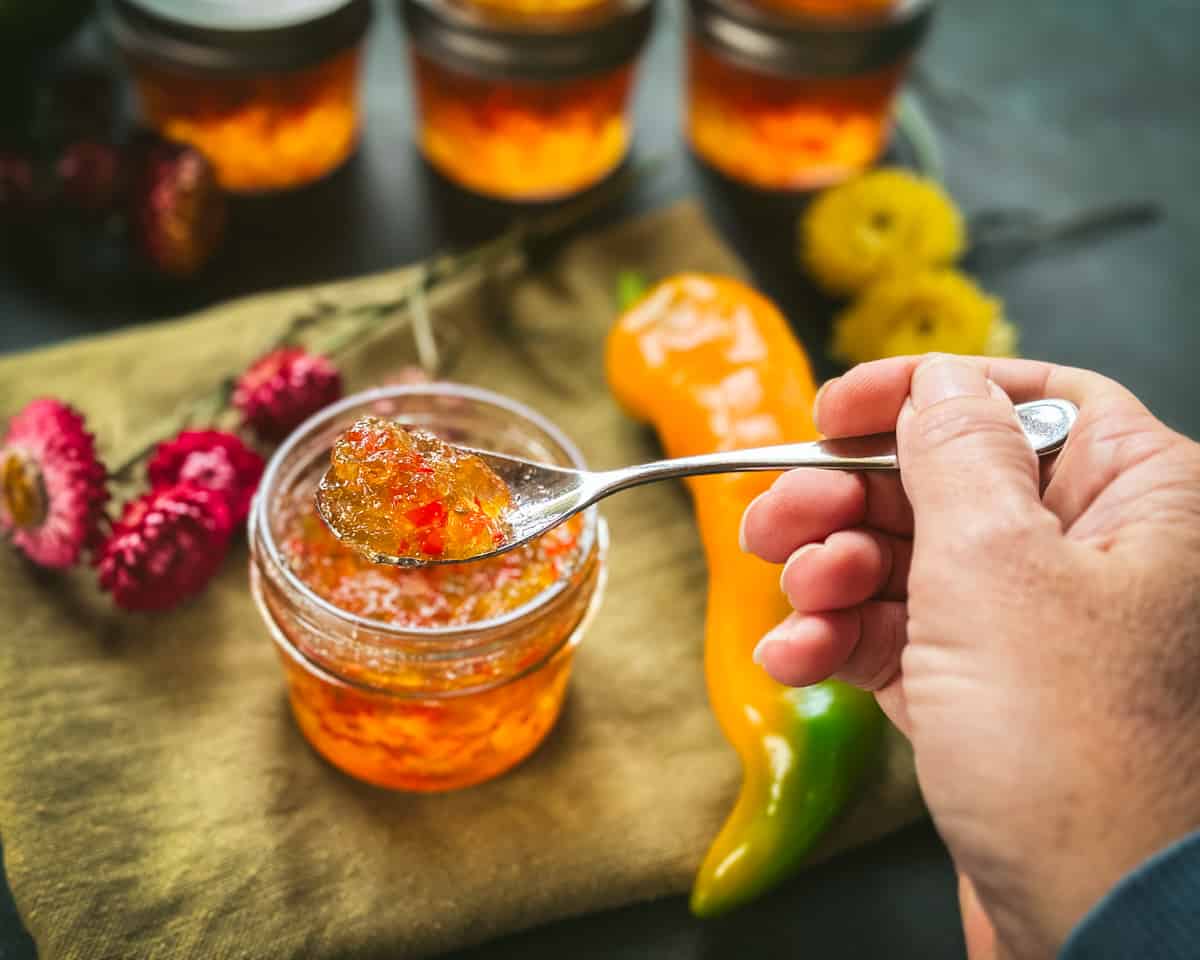
Set a small jar out on a charcuterie or cheese board, use it as a glaze on meat, cook meatballs in it, top it on baked brie, or use it to cook your veggies in. The possibilities are endless!
Since this pepper jelly is canned, it can be stored on a shelf for a year or more until ready to use. Once opened, keep it in the refrigerator for 6 months.
Need More Jam & Jelly in Your Life?
- Dandelion Jelly w/ Low-Sugar or Honey
- Hard Apple Cider Jelly
- No Sugar Apple Jelly
- Low-Sugar Lilac Jelly
- No Sugar Blueberry Jam
- No Sugar Peach Jam
- Low-or-No-Sugar Strawberry Jam
Pepper Jelly
Equipment
- 6 4oz Canning Jars or 3 Half Pint Jars
Ingredients
- 1 ⅓ cup bell and/or hot peppers seeded and finely chopped
- 1 ⅓ cups white vinegar 5% acidity
- 2 teaspoons calcium water from the Pomona’s Pectin box
- 2 cups sugar divided (or 1 ½ cups honey)
- 1½ teaspoons Pomona’s Pectin
Instructions
- Prepare your boiling water canner for a water bath method. Put the canning rack at the bottom of a large pot and heat the jars in simmering water until it’s time to use them. Wash the lids in warm soapy water and set aside until ready for use.
- Mix the calcium water as per Pomona’s Pectin instructions.
- Measure the finely chopped peppers into a saucepan.
- Add the vinegar to the saucepan, then bring the peppers and vinegar to a boil and simmer covered for 5 minutes.
- Turn off the heat, add 2 teaspoons of calcium water, and mix well.
- Measure ½ cup of the sugar (or ½ cup of honey if using) into a bowl. Thoroughly mix the pectin powder into the ½ cup of sweetener. Set aside.
- Return the pepper mixture to the heat and bring to a full boil. Add the pectin-sweetener mixture, stirring vigorously for 1 to 2 minutes to dissolve the pectin.
- Add the remaining sugar or honey to the pepper mixture once the pectin is dissolved. Stir well and return to a full boil. Once the jelly returns to a full boil, remove it from the heat.
- Use a jar lifter to place the jars onto a wooden cutting board or kitchen towel and ladle the hot jelly into a canning funnel to pour the jam into the prepared jars. Leave about 1/4 inch of headspace and remove any air bubbles.
- Wipe the rims of the jam jars and center a lid onto each jar and apply the band, adjusting to fingertip tight. Place the filled jars into the boiling water canner, making sure there is 1-2 inches of water covering the jars.
- Process the jars in a boiling water bath for 10 minutes (add 1 minute more for every 1,000 ft. above sea level). Turn off the heat, remove the pot lid, and let the jars sit inside for 5 minutes.
- Use a jar lifter to remove the hot jars and let them cool for 12 to 24 hours. Check to make sure the lids are all sealed, they should not flex when the center is pressed.
Notes
- Pomona’s Pectin comes with 2 packets, the smaller one with calcium powder is needed to make the calcium solution with water. The larger packet has pectin powder that is added to the sugar while making this jelly.
- Any color or type of peppers can be used for this recipe, mild or hot, or a combination of the two. It’s important to not use more than the stated 1 1/3 cup of peppers, however, to keep the right acidity for canning.
- Apple cider vinegar can be substituted for white vinegar as long as it has 5% acidity.

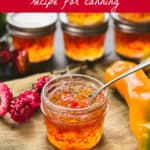

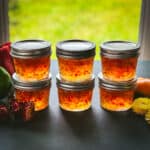

What if you don’t have calcium water
This recipe uses Pomona’s Pectin. The calcium water comes in the package with pectin!
I used to make peach pineapple pepper jelly all the time. I lost my recipe. But it sounds similar to this. If you were to add peaches or pineapple to it, how much would you add of those? Thank you so much!!
Hi Dawn. I’m not really sure, since I’ve never made it. I would find an approved canning recipe for pineapple jelly and then modify it by adding the chopped peppers.
Can we store the left over calcium water for future use? And for how long , and stored is it in the fridge ?
Yes, stored it the fridge, it’ll last a few months.